Other than a Champagne Turkey (maybe stuffing) there is nothing more iconic to a Thanksgiving spread than turkey gravy. It’s a requirement, like trying to serve bread without butter.

Turkey Gravy From Drippings
The only big questions is do you make turkey gravy with drippings or turkey gravy without drippings.
For my easy turkey gravy recipe, you can make it either way and BOTH will be delicious and rave-worthy. Yes, I just made that word up…
There are a couple of aspects and questions that come up when making any type of gravy at home. Let’s address those first and then get into the mechanics of how to make turkey gravy specifically.
I know this post is long, but I promise you, ALL of the information is useful and not just a boring story about my family.
How to Fix Lumpy Gravy
The first, is undoubtedly, the issue of lumpy gravy. Lumpy gravy is usually the result of trying to thicken the sauce and not doing it properly.
The unfortunate issue is that after you lump it it, no amount of whisking is going to make it smooth. Those lumps are there to stay. There are only two ways to fix the problem.
- Sieve. The first is to remove the lumps by pouring the gravy through a fine mesh sieve or small holed colander. If you only have a large holed colander, line it with cheesecloth. You will lose a little gravy absorbing into the cheesecloth though.
- Immersion blender. The second is to use an immersion blender or transfer the whole mixture to a stand blender (not a stand mixer, an actual BLENDER) and give a nice whirl.
But you can prevent lumps pretty easily. The basic elements to thicken gravy are flour, cornstarch or arrowroot. Any of these three needs to be mixed with a small amount of water before being added to the larger batch of gravy. Flour is usually added before in the form of a roux.
Other lumps sometimes come from pieces of food or seasoning, but those are the good kind of lumps. You can smooth those with an immersion blender, if desired.
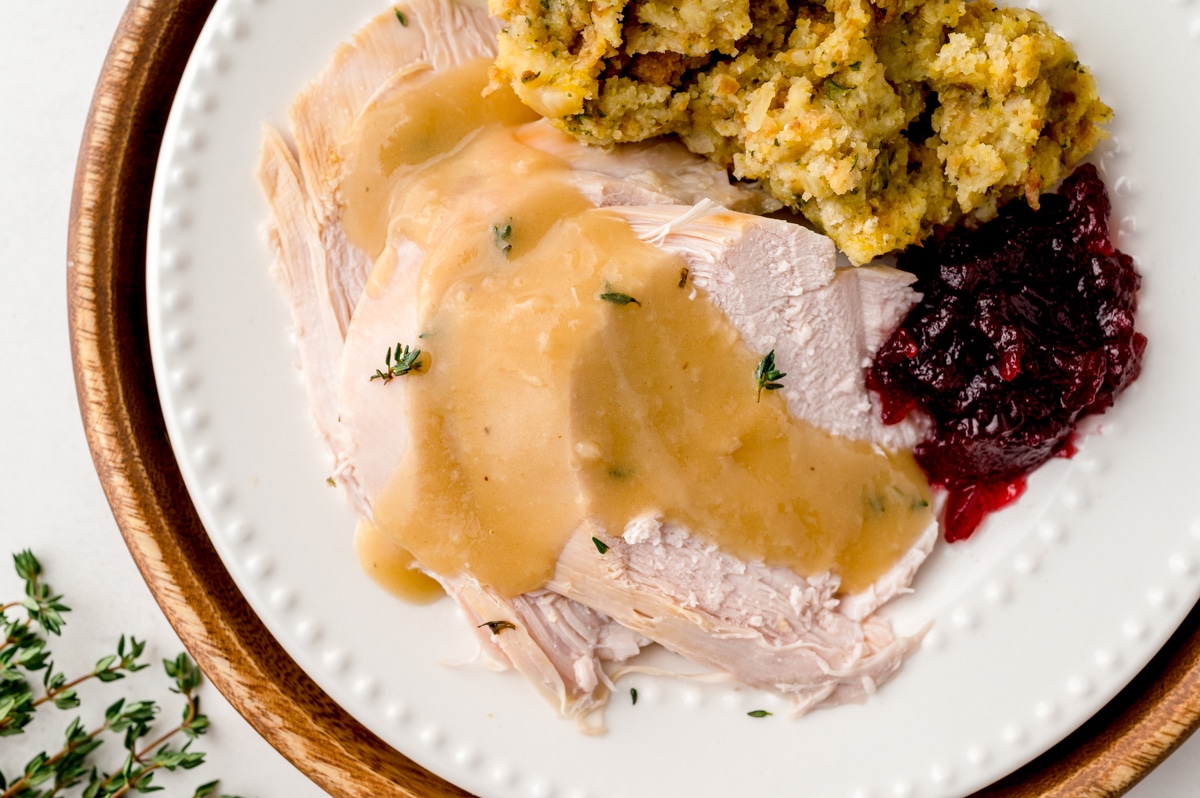
How to Fix Salty Gravy
The next issue is that gravy is too salty. Generally this happens because the cook has seasoned the gravy too early in the cooking process and the other ingredients already carried a lot of salty flavor.
Drippings and broth, stock or bullion are all going to carry a certain amount of their own saltiness. Until it is all combined, you won’t know how much, if any, salt is needed.
So how do you reduce saltiness in gravy? There are a few techniques and the first one might surprise you!
- Potatoes. Chop up a potato and add it to your gravy. It will absorb the salt in about 15 minutes. Fish out the potato chunks using a slotted spoon or run it through a colander. Although I haven’t tried this technique, it is touted by Better Homes & Gardens, so I am guessing it works!
- Sugar and pepper. The second is to counterbalance salt with sugar and pepper. Both will help balance the flavor profile. Start with just a teaspoon of sugar and quick pinch of pepper, stir well and taste. Add more as needed.
- Dilution. The last way to reduce salt in gravy is all about ratios. You can dilute the gravy by adding more liquid and a tablespoon of butter.
You might also end up with WAY more gravy than you need, but I supposed that is better than not having gravy at all.
Add 1 cup of turkey or vegetable broth )or just plain water if the stock was what was contributing to the saltiness to begin with) and 1 tablespoon UNSALTED butter. Salted butter will just add to the saltiness.
Turkey Gravy Ingredients
Although grabbing a gravy packet at the grocery store is super easy, making a delicious turkey gravy from scratch is almost just as easy! The simple ingredients can more than likely already be found in your pantry.
- Butter – Always use unsalted butter when cooking. that way you’re able to control the amount of salt that goes into the recipe. If all you have is salted, make sure to taste it before adding any additional salt. You can also use a flavored butter or our famous herb turkey butter.
- Flour – When butter and flour are mixed together, they form a paste called a roux. See my notes above on exactly how to make one. All purpose flour works great here.
- Broth – You can use chicken stock, vegetable broth or even homemade turkey stock if you happen to have some on hand.
- Leftover pan drippings – Drippings is the collective term for what is left in the roasting pan after cooking your turkey, what has “dripped” off. This is usually a combination of fats, juices and seasoning. As you can imagine, this is like a flavor bomb! A little goes a long way.
- Kosher salt & freshly ground black pepper – Add these to taste. If using unsalted butter, omit the extra salt here completely.
- Other flavor add-ins – Making a flavorful gravy is all about the flavor add ins. I have a list of suggestions above, and they range from bay leaves and fresh thyme to worcestershire sauce and soy sauce. Whatever your flavor preference, it will make the perfect gravy.
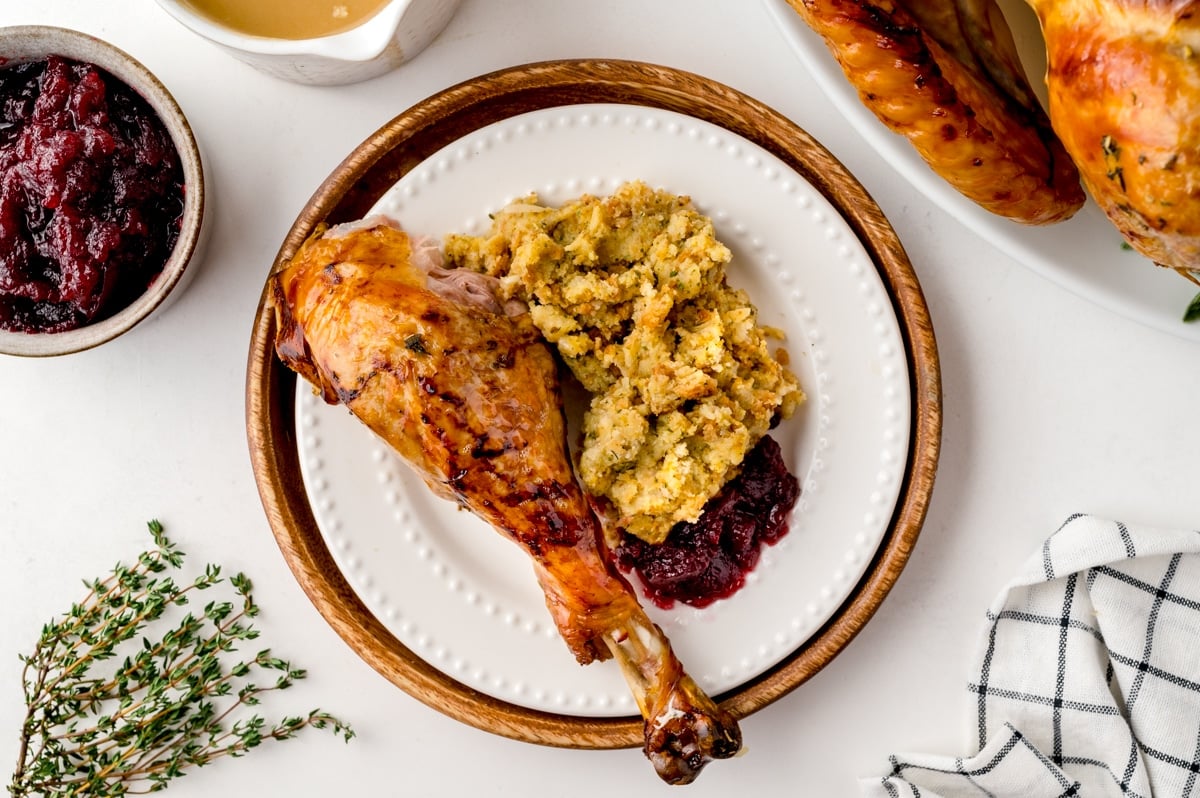
How to Make Homemade Turkey Gravy Recipe
I’m here to tell you that besides buying a jar of creamy gravy at the store, this is the easiest way to make classic turkey gravy. This delicious gravy recipe always gets rave reviews and besides the turkey, might just be the star of Thanksgiving dinner.
- Melt butter. Melt butter over medium heat in a heavy bottom saucepan.
- Whisk in flour. When melted, whisk with flour until a paste forms. Continue to whisk the flour mixture until roux starts to brown and become fragrant.
- Add broth to roux. lowly add broth and drippings while whisking vigorously, getting all those little browned bits up from the bottom of the pan, these are like little flavor bombs. Continue to whisk until fully heated.
- Taste. Taste test for seasoning. Add Kosher salt and freshly ground black pepper sparingly until desired taste is achieved.
- Seasonings. Add other seasonings, if desired and continue to heat for 5-15 minutes.Serve. Last thing to do is to add to a gravy boat and pour this perfect turkey gravy all over your Thanksgiving turkey and mashed potatoes.
Liquid
The liquid is generally turkey stock, but you can also use vegetable stock, chicken broth (even if it is for turkey) or just plain water. Make your own or buy store bought stock.
You can buy it in liquid form or as a bullion. Make sure you taste it before adding it to the pan so you can get a sense of the flavor intensity and salt.

Roux
The next is a thickening agent, which also ends up being the thorn in the side of most cooks. Many gravies are thickened using a roux which is equal parts fat to flour or sometimes equal parts liquid to flour.
Pro Tip
There are 3 types of roux: white, blond and brown, depending on how long they have been browning. A brown roux has intense flavor and smells like popcorn.
Roux is the base for many sauces in different types of cuisine, but best known in French and Creole.
Roux fats for gravy are typically turkey drippings, butter or oil. I prefer using unsalted butter. The drippings and stock will have a good amount of salt, so I try to reduce it in other areas and then correct seasoning at the end of cooking.
- The standard roux ratio is equal parts fat to flour. Small batches only need a tablespoon, larger might need up to three.
- Cook and whisk the roux until it smells nutty or like popcorn, also known as a brown roux. It will be mealy and cakey.
- You can thin out a thick gravy, but it’s harder to thicken a thin gravy. In other words, start with less liquid than you think you need and add until you get the correct thickness.
- Roux gravies thicken as they cool, check the consistency before serving to make sure you don’t need a touch of water before sending it to the table!
Seasonings
Lastly, the seasonings. The best way to season gravy is by using drippings from the dish you’ll be serving it over, but that isn’t always possible. If there are lots of drippings and liquids, put them into a fat separator to not have too much fat in the mix. Some will be drier and you can just spoon the bits off the bottom of the roasting pan.
Alternately, you can add the turkey neck from the little package of innards in the turkey. Just fish it out before serving.
It is possible to make turkey gravy without drippings, you’ll just need to add your own seasoning. I like to use my Turkey Rub, Homemade Seasoned Salt or Poultry Seasoning.
You can even add fresh herbs and spices to your gravy using drippings to intensify fresh, earthy flavors. Add them, allow them to simmer and then fish them out before serving.
Make an herb bouquet to keep them all together and make removing them easier. Ball your desired spices and herbs in a piece of cheesecloth.
Tie it at the top with cooking twine and add the whole thing to your gravy to seasoning. Pull it out when you feel it has reached the desired level of flavor!
My favorite herbs, spices and flavors to add to gravy are:
- Sage
- Thyme
- Rosemary
- Whole Anise
- Nutmeg
- Cardamom Pods
- Allspice berries
- Sherry
- White Wine
- Red Wine
- Giblets
- Onion
- Garlic
- Apples
- Apple juice
- Orange juice
- Cream or Half & Half
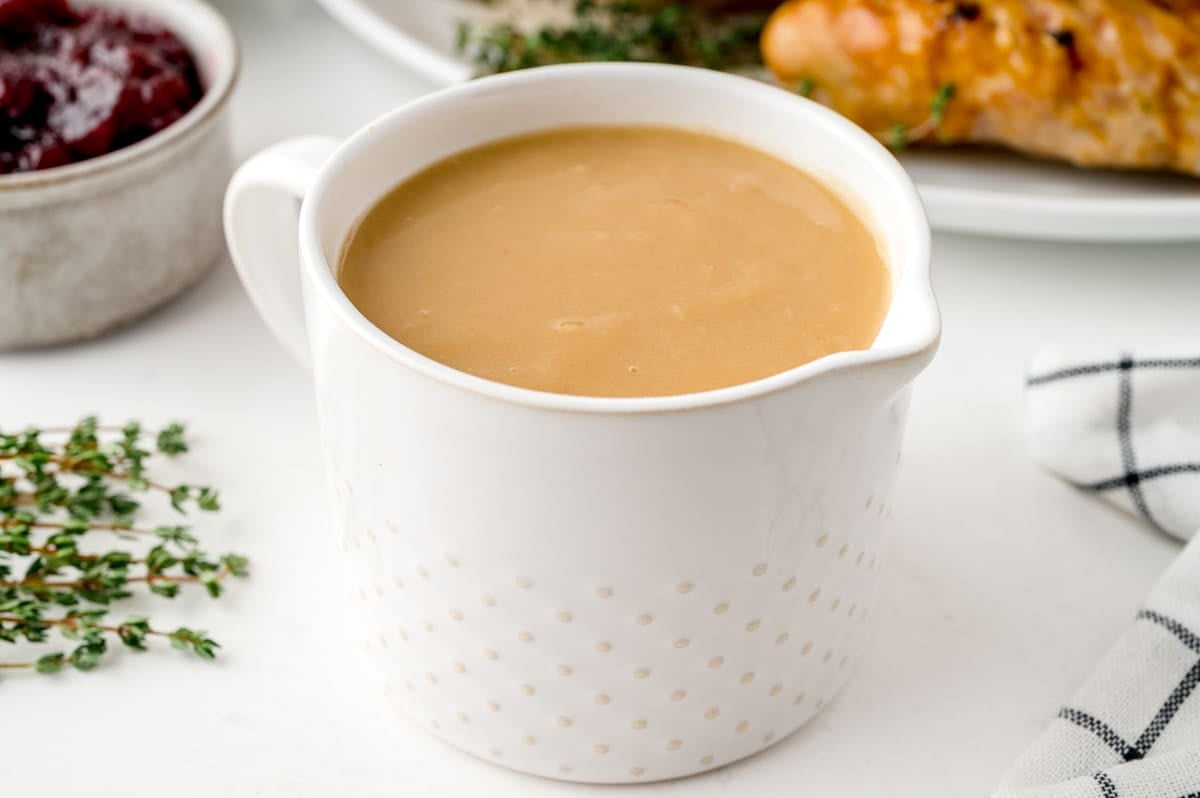
Turkey Gravy without Drippings
Melt butter, whisk with flour until a paste forms. Continue to whisk until roux starts to brown and become fragrant. Slowly add broth while whisking vigorously.
Add a teaspoon of turkey rub or other seasoning blend. Start small and add more as needed.
It is easier to add more flavor than to dilute it later. Stir constantly until fully heated and desired consistency. Add other seasonings, if desired and continue to heat for 5-15 minutes. Gravy should easily coat the back of a wooden spoon.
Taste test for seasoning. Add Kosher salt sparingly until desired taste is achieved.
Storage and Freezing
How to Store Turkey Gravy
Store any leftover turkey gravy in an airtight container in the refrigerator for up to five days. Reheat in a saucepan over medium-low heat. Leftover gravy will most likely thicken, so add a small amount of water, stock or wine to thin it out.
Can I Freeze Turkey Gravy?
You can definitely freeze this gravy too. Try adding to an ice cube tray for individual servings. It might defrost a little thick, and you may have fat rise to the top. But thin it out with water, stock or wine and it’ll be just fine.
Recipes to Serve with Homemade Gravy
If you ask me, gravy tastes great on almost anything! But here are some of our favorite things to serve with it.
And if after ready ALL of that you are totally overwhelmed and don’t want to make your own gravy, here is a quick recipe for dry gravy mix. It uses beef bouillon, but still taste amazing!
Homemade Turkey Gravy
Equipment
Ingredients
- 1/4 cup butter
- 1/4 cup flour
- 2 cups broth
- 2 tablespoons drippings* see notes for seasoning without drippings
- Kosher salt & freshly ground black pepper , to taste
- Other flavor add-ins
Instructions
- Melt the butter over medium heat in a heavy bottom saucepan.
- When melted, whisk with the flour until a paste forms. Continue to whisk until roux starts to brown and become fragrant.
- Slowly add the broth and drippings while whisking vigorously. Continue to whisk until fully heated.
- Taste test for seasoning. Add the salt and freshly ground black pepper sparingly until desired taste is achieved.
- Add other seasonings, if desired and continue to heat for 5-15 minutes.
- If you run into problems, such as your gravy being too thin, too thick, too salty or having other issues, check this post for common gravy problems and how to solve them!
- If you’ve tried this recipe, come back and let us know how it was in the comments or star ratings!
Notes
- 3-4 leaves sage
- 2-3 sprigs fresh thyme
- 2-3 sprigs fresh rosemary
- 2-3 whole anise pods
- 3-4 grates of fresh nutmeg
- 2-3 whole cardamom pods
- 1 teaspoon whole allspice berries
- 1 tablespoon sherry
- 1 tablespoon white wine
- 1 tablespoon red wine
- 2-3 tablespoons finely chopped giblets
- 2-3 tablespoons minced or grated onion
- 2-3 cloves finely minced or grated garlic
- 2-3 tablespoons grated apple
- 1/3 cup apple juice
- 1 tablespoons orange juice
- 1/4 cup cream or half and half
Nutrition



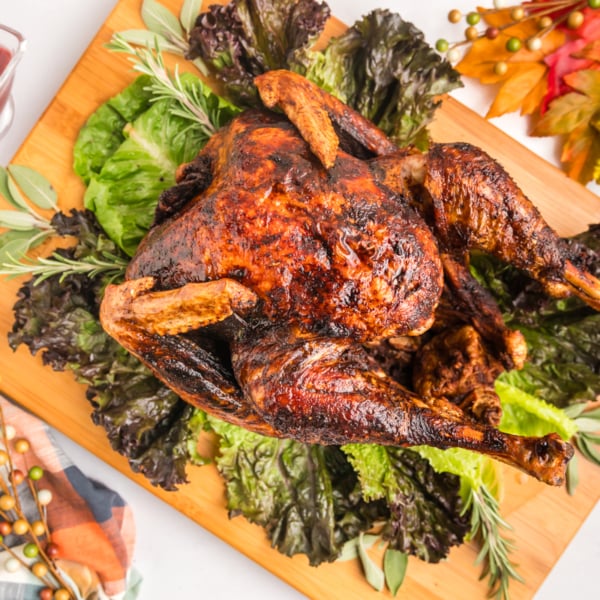






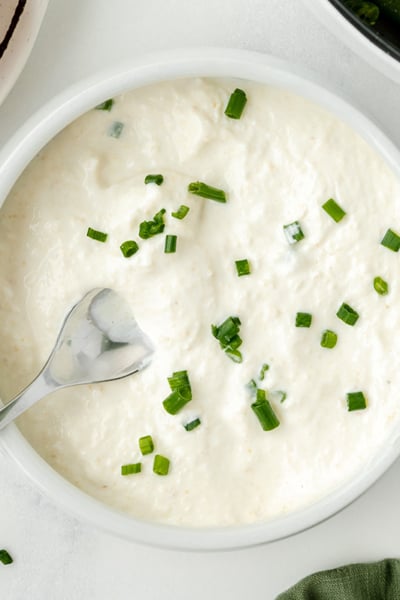













So good- the perfect comfort food. Not overwhelming, but still flavorful.
Wow, I love all the info and tips in this post. I always have difficulties with reducing saltiness. I love the potato idea. I will try it next time for sure.
Wow! So creamy and flavorful; this will be a hit at Thanksgiving dinner! Delish!
I love how easy this gravy is to make. Really appreciate all the instructions to make it perfect.
This recipe is a keeper! Thanks for sharing